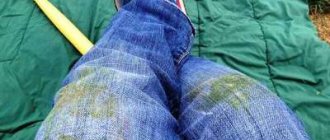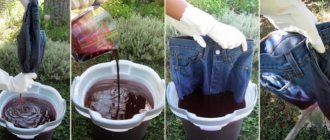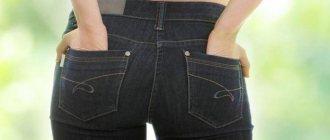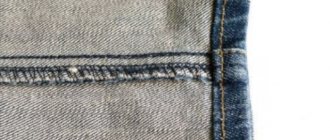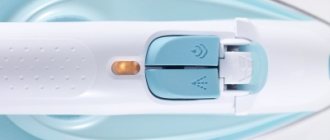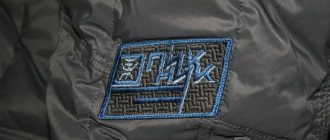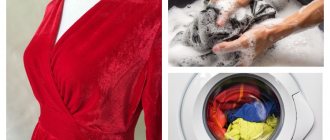The metal button on jeans is installed by the manufacturer using a special device. Therefore, changing it at home can be problematic. This is due to the fact that it is not sewn on like regular hardware. However, even such heavy-duty fasteners often become unusable and require replacement. This happens especially often if the metal rivet is located on the waist line and is constantly exposed to increased loads. What to do and how to replace the iron fastener on a denim product yourself, we will consider in this article.
How to install a spare button yourself
To properly insert a new rivet into a denim product, you need to decide on its diameter and type.
There are several sizes of fittings for denim trousers. You need to choose one that fits the existing loop. Depending on the type of fastening and the type of stud on which the button is installed, the following types of fittings are distinguished.
- With a round notch.
- All metal with smooth base.
- Smooth metal hollow inside.
Important! The best option for everyday jeans is a button with an aluminum shank. This metal is strong and stable. But at the same time, it is much easier to work with than with steel models of fittings.
Installation methods
Depending on the type of fastening, their installation method also differs.
Buttons on a stable foot
This is the simplest option that can be used at home.
- To install, you need to make a hole in the denim with an awl, nail or hand punch.
- Then a fastening nail is inserted into the hole.
- The button head is driven into it like a regular nail. The main thing is not to use too much force, otherwise the fittings can be damaged.
Denim rivets on a stable leg with a hole
Installation is carried out on a smooth all-metal nail, similar to the first method. However, it will first have to be shortened. Since in most cases it is slightly larger than expected and protrudes above the attached button.
Broken leg mount
Such fittings must be installed on a strong wooden surface.
A metal tubular or regular smooth nail is used. It is quite difficult to maintain alignment during installation, so you will additionally need a bolt and a tube about 10 mm long.
If available, you can use a socket wrench. The rivet is driven into its proper place and the quality of installation is carefully checked. To do this, you need to pull it in different directions so that it does not jump out.
Fittings on a broken leg with a hole
They are installed on a solid metal nail, preferably aluminum. It is also possible to use a tubular metal nail.
We need a flat, level surface. The fabric is pierced with an awl and a nail is inserted, then the button is hammered onto the nail. It is much easier to do this if the nail has a circular notch.
Double fastening rivets
The main difference is the flat mounting base. It is pierced using two nails, which are part of the fittings themselves. And then the spikes protruding from the other side are bent towards each other to make the task easier and make the installation more accurate. First, use an awl to make two holes in the denim.
Important! When installing a button, you may find that the stud is too long in relation to the fabric. In this case, it can be easily shortened using pliers.
If a person does not have the necessary skills, tools or a lot of patience, it is better to contact a professional studio or workshop. Here, using special equipment, the rivets will be quickly and accurately restored into place.
If you want to do everything yourself, you should first study all the replacement technology and the types of fittings used.
Removing glue from denim
Let's look at the most effective recipes for removing glue, taking into account its quality. When using caustic products to remove stains, do not forget to wear protective gloves, otherwise you may cause skin irritation or allergies.
Removing glue from denim
How to remove office glue
Office glue is likely to be found in every home where there are small children. After all, with the help of this particular tool you can create paper crafts. If this type of glue gets on your jeans, you can remove it with regular laundry soap.
- Jeans should be soaked in cool water, the stain should be soaped and left for 20-30 minutes.
- After time, the contamination is washed off by hand.
- Next, the denim item can be put in the washing machine, or rinsed and squeezed manually.
Getting rid of PVA
PVA glue is a little more difficult to wash off than stationery glue.
- The planted stain must first be rubbed with a piece of gauze or cotton wool soaked in alcohol. If there is no alcohol, nail polish remover or acetone will do.
- Afterwards, the area of contamination is also rubbed with laundry soap and the product is soaked for 20-30 minutes.
The final step will be hand or machine washing.
Rubber glue (Moment, Super glue)
Rubber-based glue cannot be washed off. Here you will have to use quite caustic liquids. The fresher the stain, the easier it will be to remove. There are several products that can deal with rubber adhesives.
- Stain remover for colored fabrics . You need to take a small piece of gauze or other soft, liquid-absorbent fabric and thoroughly blot it with stain remover. The fabric is applied to the stain for 15-20 minutes. After time has passed, the stain must be wiped off with the same swab, then washed by hand in powder, or better yet, in laundry soap.
- Solvent. You should not keep a swab with solvent on denim; there is a high risk that it will fade. Moisten gauze in the liquid and simply rub the glue well with it. Then the item is soaked in water, the area of contamination is rubbed with laundry soap. After about 20 minutes, you can wash your jeans in any convenient way.
- Gasoline . The method for removing glue from jeans using gasoline is exactly the same as using solvent.
- Vinegar . Soak cotton wool or gauze in 9% acetic acid and apply it to the stain for 15 minutes. Next, the product is soaked by soaping the fabric with laundry soap, and washed after half an hour. Instead of vinegar, you can use citric acid (dissolve 1 tsp in 100 ml of warm water).
Removing hot melt adhesive
Hot-melt adhesive is sold in the form of hard “sticks”. It is converted into a liquid state using a special heat gun. Since this type of glue becomes soft under the influence of high temperature, it is removed with an iron.
- You need to take two pieces of gauze or other soft fabric and place them on both sides of the jeans in the area of the stain.
- Then the substrates are ironed with a hot iron for 30 seconds and immediately removed. Most of the glue should remain on the pieces of gauze.
If the glue is not completely removed, the procedure should be repeated using clean pieces of fabric.
Cleaning superglue
Many people know that superglue is one of the most “thermonuclear” and it is very problematic to remove it from fabric. But there are some recipes that can cope with such an aggressive substance. All of the following products are very caustic and care should be taken when handling them.
- Demixide. This medicine is sold in pharmacies. Demixide is very toxic and can instantly burn the skin; you only need to work with it while wearing gloves. A cotton pad or gauze swab is moistened in the product and applied to the stain for 10-15 minutes. Demixide can even remove old superglue stains from jeans. After grouting the dirt, you need to soak the jeans in a soapy solution for half an hour and wash them at the end.
- White Spirit. The liquid is sold in hardware stores and is a very effective solvent. A small piece of gauze is soaked in this solution and applied to the super glue stain for 15 minutes. Afterwards – regular washing, preferably by hand.
What and how to replace if there is no spare button
If there is no desire and opportunity to tinker with new metal rivets, and also do not have the means to contact a professional studio, it is quite acceptable to replace the rivet with a regular button . The main thing is that it matches the overall style of the product and is suitable for the diameter of the loop.
- In order to sew a button on jeans, you first need to remove the old rivet.
- Then the hole from the fittings is carefully mended, leaving no unsightly holes.
- A button on the leg is sewn very close to that place.
In some cases, such fittings hold much more securely and look more attractive than standard metal rivets.
How to crochet a button?
Coral beads: jewelry for healing
How to remove a blind rivet
The pop rivet is somewhat easier to remove. When dismantling it, it is necessary to remove the ring formed during fastening. If possible, when compressing the material of the structure, insert a metal saw blade, the fastening can be cut off, and the pin can be removed by pulling it out by the rod. If sawing or cutting is not possible, there is always a chance to remove the fastening using the first method - drilling.
The hidden fastening can only be removed by drilling, and the exhaust heads can be knocked off with a hammer if the strength of the material they fasten is greater than that of the fastening itself. Provided that using this method of dismantling, there is no confidence in 100% safety for your own hands and the appearance of the material, it is better to abandon it.
If you find an error, please select a piece of text and press Ctrl+Enter.
Denim buttons. Select and install
Denim buttons appeared with denim clothing, which was originally a uniform for hard work.
For rough fabric, reliable fittings were needed. Firstly, it had to be attached directly to the material - the threads could not withstand the load. Secondly, increased strength was required from the button itself, so it was made of metal.
Today, denim clothing is more widely used, as are denim buttons.
How a button works
A denim button consists of a cap and a stud on which it is attached. Fittings can be of different shapes, sizes and fastening mechanisms.
The shape of a button is determined by its cap and can be:
- round,
- square,
- square with rounded corners,
- hexagonal.
The most comfortable ones are round denim buttons, as they are the easiest and fastest to insert into a buttonhole.
The cap can be convex, concave, straight or semicircular. The size is determined by its diameter in mm: 14, 17, 19, 20, 22, 25, 26, 30, 40.
According to the form of fastening, denim buttons are:
- on a fixed leg;
- on a floating or broken leg, thanks to which the button remains movable after being attached to the product.
Carnations are also divided into the following types:
- with a circular notch - the most reliable fastening option;
- smooth all-metal;
- smooth hollow;
- double, or with two spikes.
The hat can be solid or with a through hole in the middle.
It is not recommended to buy denim buttons in parts, that is, studs separately from hats, since their characteristics depend on the size, material and manufacturer. Even elements of the same size, but from different manufacturers, may not fit together.
Areas of use
You can buy denim buttons for sewing any items made of thick or rigid fabric, where the design style allows it.
They are installed on jackets, trousers, overalls for children and adults, work and workwear, and bags. In addition, fittings are often used not only as a functional, but also as a decorative element.
We make denim buttons from metal treated with anti-corrosion compounds. The material can withstand temperature changes and prolonged exposure to moderate humidity. Resistant to dirt and chemical compounds. It tolerates washing well and is not afraid of ironing.
How to install a button
In the sewing industry, fittings are installed using special equipment: presses. For an enterprise with a small production volume, manual ones, with a lever or an impact mechanism, are suitable. In large industries, electromechanical devices are used.
You can install or replace a denim button at home using improvised means. You will need:
- awl - for piercing the fabric in the place where the fittings will be installed;
- hammer;
- pliers;
- bolt (for buttons with a through hole);
- metal tube for fixing the floating leg.
You will also need a stable workspace, preferably one with a wooden surface.
Buttons on a stable foot
It is necessary to pierce the fabric, insert a nail into the puncture and hammer it into the upper part of the button. This must be done carefully so as not to pierce the cap through.
If the cap has a through hole, the stud may stick out of it. In this case, you need to first shorten it to the required length with pliers.
Can't shorten a nail? Try cutting out a plastic tab and inserting it between it and the cap.
The point of the nail in such a button needs to be flattened. To do this, insert a bolt into a hole of a suitable diameter and lightly hit it with a hammer until the tip of the nail flattens it.
Buttons on a broken leg
Fittings of this type are installed on smooth studs, solid metal or hollow. This will be more difficult to do than in the previous version, since the button is movable and the nail is smooth, which makes it twice as difficult to center.
A tube with a diameter equal to the floating leg can help with this. We place it on the leg, fixing the even position of the latter, and install a nail.
To simplify the process of installing a button, special kits with plastic press fasteners will help.
Double foot buttons
The back side of the cap of such a button does not have holes, so you will have to make them first. An awl or a regular nail is suitable for this.
Then we proceed according to the following algorithm:
- We pierce 2 holes in the fabric and insert the spikes of the legs into them.
- We put a hat on the leg.
- In the through hole of the cap we bend the tips of the spikes inward. A regular screwdriver will do for this.
- We secure the result with a bolt, as described above.
Denim buttons are reliable and do not come off under stress, as they are attached to the fabric. Used for sewing clothes from dense, rough materials. Often the buttons have an engraving, so they also serve a decorative function.
If you need to install 1-2 buttons, this can be done manually. For sewing production, even a small one, you will need a press: manual or electromechanical.
You can buy sewing accessories cheaply . Call!
Source: https://mk-furnitura.ru/interesting/dzhinsovye-pugovicy-vybiraem-i-ustanavlivaem.html

